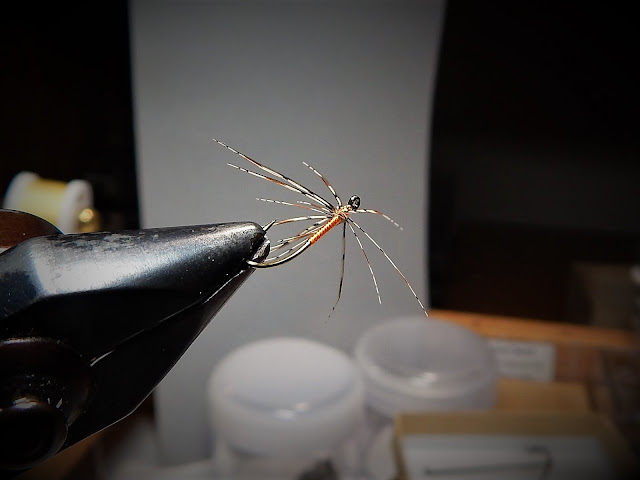I have been reading John Atherton's book The Fly and The Fish and I have found some of his written words that have matched mine. He was way ahead of his time when he wrote about the fly, both alive and the one tied by the angler. He tells about seeing a mayfly and describes it like this...it was an exquisite creature, the wings were nearly transparent, of iridescent pearly color. The upcurved body was shaded darker on the back tapering slender whisks of a long tail.All of it's legs were marked with color, speckled and delicately shaded....his description is that of an adult mayfly, but those same characteristics apply to that mayfly as it emerges from it's nymph stage. So as you see in the first photo of a Partridge and Orange spider the sparse delicate imitation of that delicate mayfly Atherton described.

Heavily hackled flies have an appeal to most fishermen, and there are probably numerous reasons why the heavily hackled flies are desired. But when it comes to the true likeness of the natural it's the sparsely tied spider that will win the game.
The wild brown trout. Is there any fish that swims that is more wary, more cunning and possess more stream savvy that the brown...the sparse Partridge and Orange spider fooled him.
40 days 'til spring.




Nice post Alan. Especially liked the last photo. We've had spring like weather the last few days in the 60's but it ends Thursday.
ReplyDeletebillp
DeleteThanks
Bill those lovely flowers poking up through winters debris sure lifts the spirits. I would love to see some 40's..8 degrees this am. Snow tomorrow.
You've got me re-reading "Wet Flies" by Dave Hughes. :-)
DeleteBill I'm sure you'll find something you missed the first time you read it.
Delete-8 below in the Minnesota Driftless today, but that is better than the -20 yesterday morning.
ReplyDeletedpnoll
DeleteThanks
David those minus numbers are scary. Some say you get accustomed to them but not this guy. Bring on spring.
Beautiful spiders, Alan. Atherton's book is a great read; the man led a very interesting life.
ReplyDeletemike
DeleteThanks
Mike the more I read the more I'm impressed. In reality it's not complicated, fly construction...keep it simple.
Alan, I need to get more disciplined in tying my soft hackles. It seems I can't help myself tying in another wrap or two of hackle. I can see how the sparse hackle would seem more realistic to the fish. I splurged for a new Hungarian partridge skin and now have plenty of feathers to tie with.
ReplyDeleteBest, Sam
Sam
DeleteThanks
Sam it's a bit difficult to do. I have such a beautiful feather why not use the whole thing. Sometimes a heavily hackled fly is called for. Fast heavy water is one place that calls for such a fly. But in most cases the sparse fly is better suited.
Good morning Alan! Those Partridge and Orange are not only sparse but long legged. I literally tied some long leg variants last night so your post caught my attention right away. I've had some good days with long legged soft hackles. I believe you get more movement from hackle tied that way.
ReplyDeleteDean F
DeleteThanks
Dean there are those times when less is more. And as you said you get more movement from a sparsely tied fly. Movement is key.
Hi Alan
ReplyDeleteJohn Atherton's book is a seminal piece of work. I now often mix up my dubbing to produce bodies that are varied not just in colour but also in texture as well - just like Atherton's magic realism approach.
Those are some beautifully tied Partridge and Orange flies. This is a bit of a bogey pattern for me and has never produced any where near the catches that others experience with this fly. Not a problem you have, as demonstrated by that wonderful brownie!
Take care and stay safe
Alistair
Alistair
DeleteThanks
"Realism"...is a key factor in trout flies. Be it in a sparsely tied hackle or as you stated subtle changes in dubbing can make a difference in making a trout strike.
The P&O always gives a good performance when called upon.
Do you observe a strict spring start date?
ReplyDeleteBureboyblog
DeleteThanks
There is really no closed season on trout fishing in Connecticut. Certain waters have restrictions during parts of the year.
I never put this together, but there is a nice little wild brookie stream that I fish sometimes. It's name is Atherton brook. I'm going to need to revisit it this year, and let some sparse soft hackles sit in the current twitching. That seems like a good choice.
ReplyDeleteHibernation
DeleteThanks
Will Atherton brook is where to try a few of these spiders. Also you might want to try his #5 dry fly. It's fascinating watching the movement of those soft hackles in the water, then the awesome strike of that brookie just makes your day.
Amen to 40 days till Spring! One tip to tying a nice sparse spider hackle is to carefully strip the feathers from the “far side” of the feather you are tying in, which also helps preventing the problem of the feathers themselves tying down other feathers. You can ruin a couple of feathers doing this so gentle treatment goes a long way.
ReplyDeleteKevin
Ned Zeppelin
DeleteThanks
Kevin that is exactly how I tied those flies. The feathers are delicate especially on that first turn. If your in a hurry don't attempt to tie them.
I think we are in for the coldest air of the winter this next week.